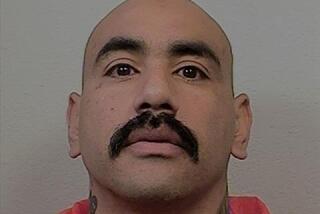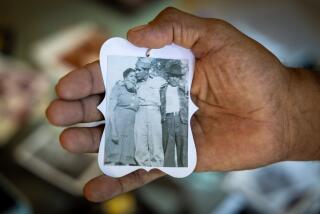The tragic intersection of 2 families
- Share via
For years the 40-foot-long cinder-block wall at the entrance to Durfee Village in Pico Rivera stood largely untouched.
Then the graffiti began appearing. PV. BXA. The city painted over it, but the graffiti reappeared. The city planted ivy. It died; the graffiti returned.
Neighbors thought the scrawling was the work of taggers.
But the graffiti was a sign of the ongoing war between Pico Viejo, a street gang that dates to the town’s inception, and a longtime rival it was trying to suppress, Brown Authority.
On Aug. 10, Maria Elena Hicks, a 57-year-old medical secretary and grandmother who had lived in Durfee Village all her life, found herself at the center of the feud when she spotted a youth spray-painting the wall and attempted to stop him.
Hicks honked and flashed her car lights at the teenager. Suddenly, another car pulled up behind her, a gunman emerged and fired into her rear window, hitting her in the head. She died three days later.
Since her death, another story has emerged in the tight-knit community. It is the tale of two longtime neighborhood families: the Quinteros -- Hicks’ family -- and the Tafollas.
Both had lived in Pico Rivera for decades. Their children played sports there and attended local schools together.
But while the Quintero family worked to better their community, the Tafollas’ neighbors campaigned to force them out.
The Quinteros pushed their children to go to college. Some Tafolla kids went to Juvenile Hall.
Of the four youths charged in the murder of Hicks, two are Tafollas: Jennifer Tafolla, 19, and the accused shooter, Angel Rojas, 16, who will be tried as an adult.
The other defendants -- Cesar Lopez 19, and Richard Rolon, 21 -- are members of Brown Authority, a gang allegedly formed by Tafollas, whose house was the gang’s hangout.
Although the two families lived six blocks apart, they were only vaguely aware of each other.
Then “their paths crossed in such a tragic way,” said Gregory Salcido, a city councilman and high school history teacher raised in Pico Rivera. “It makes you want to holler.”
Vigilant residents
Ray and Mary Tafolla arrived with their family from Compton in 1965, moving into a four-bedroom stucco house on Greenglade Avenue. Their oldest son, Tony, was 18 at the time.
“Where we lived there was all these shootings,” said Tony Tafolla, now 59, “then the Watts riots happened.”
Ray was a hardworking man, a radiator refurbisher. Mary was a housewife. They were typical of the young families moving into the new subdivisions of north Pico Rivera.
The family settled in as the rural county outpost was just beginning to take shape. In 1958, unincorporated Pico merged with nearby Rivera. East Los Angeles was a main tributary at the time, but people now mostly migrate to Pico Rivera from the heavily immigrant southeast cities of Huntington Park, Maywood, Bell and South Gate.
Though Pico Rivera was a predominantly Latino suburb, sweet sixteen parties were as common as quinceaneras and football was more popular than soccer. Most families spoke English and owned their own homes.
When the city began publishing a small part of its newsletter in Spanish in 2005, several Mexican American families complained.
Although the city has 12 gangs, it is generally free of graffiti, partly because of the vigilance of residents. The city pursued taggers, increasing penalties and recouping thousands of dollars from their families.
In this city, the Tafolla family grew. The Little League field at Streamland Park became their social center. Tony was a coach for 14 years; other family members also participated.
Although he admits to spending little time at El Rancho High School before dropping out, Tony said he vaguely remembers a pretty, cheerful girl everyone in school called Quita, as Maria Hicks was known to friends and family. But Tafolla never spoke to her.
In the 1970s, Tafolla’s younger brother, Joe, and a few others tried to start a small gang, Pico Flats, according to neighbors. They had run-ins -- including one or two shootings -- with Pico Viejo.
Joe was given the choice of joining the Army or going to jail; he chose the Army, Tony said.
His troubles, however, were a sign of things to come.
Slowly, Tafolla’s parents seemed to lose control of the family. Their house got more crowded. Generations of Tafollas lived with them, including their son, Tony, whose daughter, Mary, got into drugs and disappeared, leaving him and his wife to raise two grandsons, Angel and Bubba.
It’s unclear when, but Tony said Brown Authority was formed at the family’s Greenglade house. He said he didn’t know much about their activities and there wasn’t much he could do about it anyway.
“You can’t tell them to get out,” he said. “It’s all family.” Besides, “it wasn’t my house. I was just there. It’s my mom and dad’s.”
Neighbors remember gang members congregating outside. There were loud late-night parties. And the house and driveway were painted with graffiti.
“Pretty much the whole gang is made up of blood relatives,” said Sheriff’s Sgt. Mark Bailey. “It was a party crew, a tagging group.”
Accent on college
Ruben and Elena Quintero settled in Durfee Village in 1953. It was a small subdivision built along the banks of the San Gabriel River.
The couple ran a strict household. Their son, Ruben, and two daughters, Melinda and Quita, always went to summer school. Elena was in the PTA. When her daughters were old enough to go out on dates, she stayed up until they came home at a designated hour.
In the backyard of their small stucco house, the family planted fruit trees and palms. With stones from the nearby San Gabriel River, they built an outdoor grill, a walkway and a shrine with a statue of St. Teresa.
Ruben Quintero Sr., a former farmer turned steelworker, was a high school dropout. But he pushed his children to go to college.
“We’ve got nothing but farmers in this family,” he would say.
His son Ruben, who studied physics in college, would eventually earn a doctorate from Harvard in 18th century British literature. He now teaches literature at Cal State Los Angeles.
The son set the Quintero family on a path to higher education. Melinda went to college and became an elementary school teacher, and all but one Quintero grandchild has a college degree.
Quita was the rebel. She never liked school and dropped out at 17. But she never stopped working. She became a medical secretary, working for doctors at convalescent hospitals and for the last 11 years at Monterey Park Hospital.
“She never had a lazy bone in her,” her mother said. “That’s the one thing we can’t stand is anybody who’s lazy.”
Indeed, Quita embodied the best traits of the town, a sense of pride and ownership of their community, her family said. She knew many of her neighbors and spoke out when she found something wrong.
Her son, Matt Hicks, recalled how his mother once reprimanded some kids who were writing on a park picnic table.
“Do you want some paper? I’ll get you some paper,” she told them. “But don’t write on the tables.”
New gang rivalry
In July 2002, sheriff’s investigators noticed a spike in gang shootings in Pico Rivera’s north end. The shootings involved Brown Authority.
The gang was small, with never more than 50 members. But it was large enough to attract the notice of Pico Viejo, the same street gang that Joe Tafolla had battled years before.
At some point, sheriff’s investigators believe, Pico Viejo presented the Tafollas with an ultimatum: Join up or face the consequences.
“Brown Authority didn’t want any part of it,” said Bailey, the Sheriff’s Department sergeant. “They started warring with one another.”
The Tafolla house on Greenglade became a target. The once-tranquil street was a “battle zone,” said one neighbor. “They were firing AK-47s.”
Sheriff’s deputies were constantly called to the house. Neighbors’ homes, cars and fences were shot up. Even SWAT showed up once.
“That family was a plague,” a neighbor said.
Finally, in 2004, residents went to the city. Sheriff’s Sgt. Steve Sanchez helped them form a Neighborhood Watch. Code enforcement officers cited the Tafollas for housing violations. Deputies constantly patrolled the street.
“We hammered them hard,” Sanchez said.
Then one summer night in 2005 came the “big shooting,” neighbors said. About 3 a.m., several youths, armed with an assault rifle, opened fire on the Tafolla house.
“It was shot after shot after shot,” a neighbor said. “I yelled ‘Stay down.’ We stayed down for a good 15 minutes. Tony came out. He was shaking like a leaf.”
After that, the Tafolla family sold the house and moved to Rialto.
People in town looked on the Tafolla campaign as a successful example of civic involvement, emblematic of what the city was about.
“It was a community realizing they had a right, or an obligation, to get involved,” said Salcido, the city councilman. “That’s an American trait.”
Nevertheless, the young Tafollas kept returning to Pico Rivera to hang out with members of their gang, the Brown Authority.
“They never completely stayed away,” Sanchez said. Angel Rojas ran away from the Rialto home several times. He fled again two weeks before Hicks was killed and never returned.
‘It’s a shameful thing’
On the day of his sister’s funeral, Ruben Quintero sat under the lemon trees and 90-foot palms that his parents had planted in the yard back in the 1950s. Puffing on a cigar, he reflected on the Tafolla family.
“It’s a world without measure, where you can do whatever you goddam please,” he said. “Those people have seriously wrecked their own family. . . . It’s a shameful thing.”
In Rialto, Tony Tafolla said he hasn’t slept well since the arrest of his grandson, whom he raised from age 5. Angel is hyperactive, he said, and suffers from attention deficit disorder.
“He has the brain of a kindergartner,” Tafolla said. “He can’t read his own name. I dreamed last night. . . seen him in chains, being treated like a dog. But I say, ‘You got yourself into it. I can’t help you.’ ”
Tafolla said he won’t return to Pico Rivera for a while, though he still feels it is home.
“A lot of people hate us over there,” he said. “I understand why. I feel so bad. It’s a stupid, coldblooded killing.”
Last week, the city replanted vines along the wall at the entrance to Durfee Village. A candlelight vigil was also held in the neighborhood.
“The group of people who knew my mom, they’re touched by what happened,” Matt Hicks said. “I think they’ll try to continue on in her spirit.”
It was his mother’s love of the community that made her stand up for it, Hicks said.
“If you have something invested, you’re not going to let it be destroyed,” he said. “That neighborhood was hers.”
--
Times researcher John Jackson contributed to this report.
More to Read
Sign up for Essential California
The most important California stories and recommendations in your inbox every morning.
You may occasionally receive promotional content from the Los Angeles Times.










